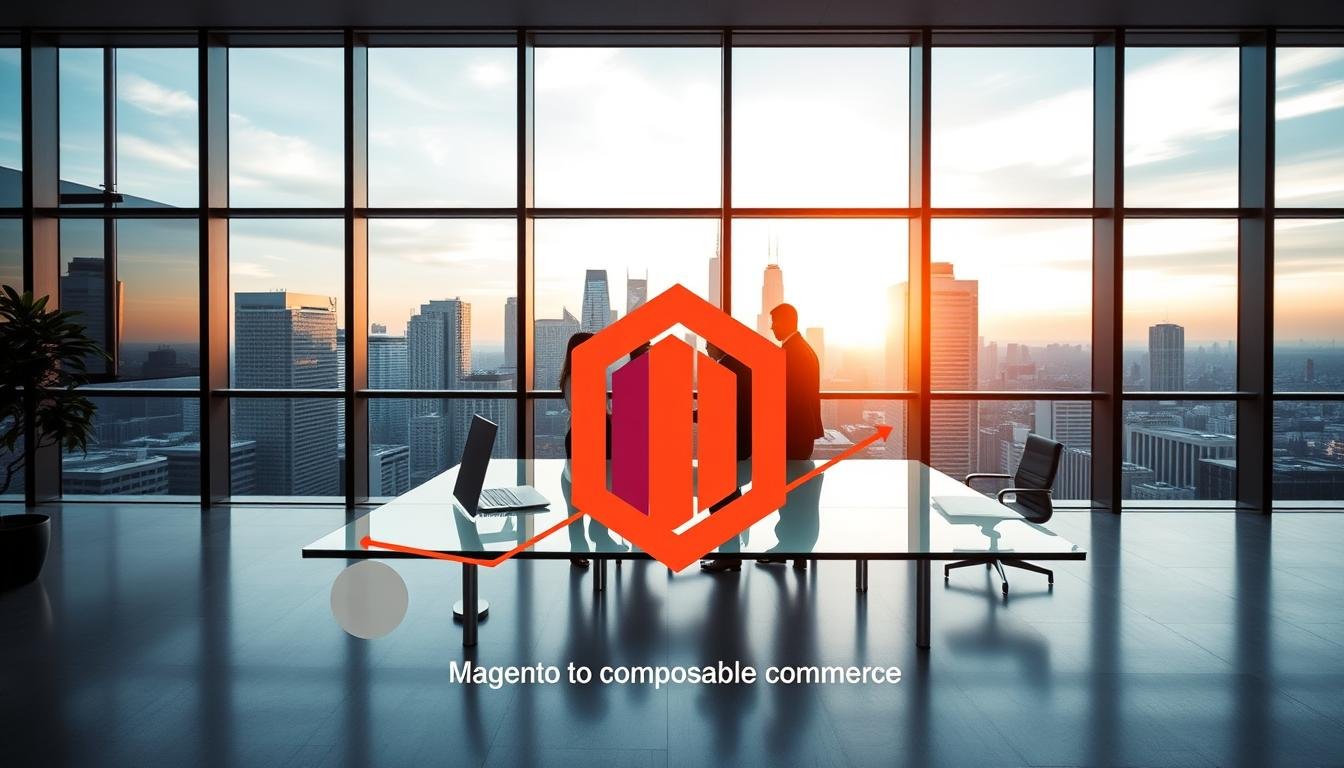What if your current ecommerce platform is silently costing you customers? As digital shopping evolves across mobile apps, social media, and live-stream channels, 72% of businesses now use modular architectures to stay competitive. Traditional systems often struggle to keep pace with these rapid changes—so how can enterprise retailers adapt?

Modern shoppers expect seamless experiences everywhere—from TikTok shops to in-store kiosks. Monolithic platforms, while reliable, frequently limit customization and slow updates. This creates bottlenecks when trying to implement new features or integrate emerging technologies.
Modular architectures solve these challenges by letting businesses mix and match tools like building blocks. Retailers gain agility to test innovations faster while maintaining brand consistency across channels. The result? Faster time-to-market and reduced development costs compared to rigid legacy systems.
Key Takeaways
- 72% of businesses now use modular solutions to keep pace with evolving customer expectations
- Decoupling frontend and backend systems enables rapid customization across channels
- Traditional platforms often lack flexibility for emerging technologies like livestream shopping
- Modular approaches reduce development costs by 30-40% compared to monolithic rebuilds
- Consistent cross-channel experiences boost customer retention by up to 23%
- Scalable architectures future-proof operations against unknown market shifts
Understanding Composable Commerce and Modern Ecommerce Trends
How do leading retailers deploy features like live-stream shopping within weeks while others take months? The answer lies in architectural flexibility. Modern digital strategies demand systems that evolve as quickly as consumer behavior shifts.

Defining Composable Architecture and Headless Commerce
Composable architecture combines specialized tools like building blocks. Unlike rigid systems, it uses microservices (independent software units) and APIs (data bridges) to connect best-in-class solutions. This approach lets businesses upgrade specific functions without overhauling entire platforms.
“Modular systems let businesses pivot faster than competitors stuck in monolithic environments,” notes a 2023 Gartner retail tech analysis.
Headless commerce takes this further by separating customer-facing interfaces from backend operations. Teams can redesign checkout flows or mobile app layouts without touching inventory management systems.
How Traditional Platforms Differ from Composable Solutions
| Feature | Traditional Systems | Composable Approach |
|---|---|---|
| Integration Flexibility | Limited third-party connections | API-first design |
| Update Speed | Months for new features | Weekly enhancements |
| Customization | Pre-built templates | Tailored experiences |
| Scalability | Vertical scaling only | Modular expansion |
MACH principles (Microservices, API-first, Cloud-native, Headless) power this shift. Retailers using these technologies report 40% faster deployment of new sales channels compared to legacy setups. API-driven architectures particularly excel at unifying data from social media shops, mobile apps, and physical POS systems.
Why Transition from Traditional Magento to a Flexible Approach
Retailers face a critical challenge: 83% of shoppers now use three+ channels before purchasing. Legacy platforms often force compromises between speed and customization. Flexible architectures eliminate this trade-off by letting teams upgrade individual components while maintaining core stability.

Enhancing Customer Experience Across Channels
Consistency drives loyalty. Shoppers expect identical product details, pricing, and promotions whether browsing Instagram shops or using in-store kiosks. Traditional systems struggle with:
| Challenge | Flexible Solution |
|---|---|
| Slow channel updates | Real-time API sync |
| Generic promotions | AI-powered personalization |
| Inventory mismatches | Centralized cloud data |
One fashion retailer increased conversions by 18% after adopting channel-specific layouts. Their mobile app showcases video demos, while desktop versions emphasize bulk pricing.
Meeting Dynamic Business Needs with Agile Technologies
Market shifts demand rapid responses. When TikTok shopping surged last year, early adopters gained 3x more Gen Z buyers than competitors. Modular systems enable:
“Weekly feature deployments instead of quarterly updates—critical for capturing trend-driven demand.”
- Voice commerce integration in 14 days vs. 6 months
- IoT device support without backend overhauls
- Real-time A/B testing across regions
This agility reduces development costs by 37% while accelerating revenue from new channels. Teams focus on high-impact innovations rather than platform maintenance.
Magento to composable commerce: A Step-By-Step Process
Enterprise retailers often discover their platform’s limitations during peak sales or expansion phases. Transitioning requires meticulous planning to maintain operational continuity while unlocking new capabilities.
Assessing Your Current Setup and Limitations
Begin by auditing your existing ecommerce platform through three lenses:
- Performance bottlenecks during traffic spikes
- Integration challenges with newer sales channels
- Customizations causing upgrade delays
One retailer found 40% of their extensions became redundant after adopting API-first architecture. Adobe Commerce excels as a backend powerhouse for order management and inventory control when decoupled from frontend constraints.
“Successful migrations prioritize components impacting revenue first—checkout flows outperform CMS upgrades in ROI.”
Mapping Out a Migration Strategy
Create a phased plan using this framework:
- Prioritize high-impact modules (payment gateways > blog systems)
- Allocate resources for parallel testing environments
- Establish rollback protocols for each phase
Teams using this architecture reduce migration risks by 62% compared to full-system overhauls. The approach lets you maintain existing management systems while gradually introducing microservices.
Planning Your Migration Journey for Enterprise Success
How do enterprise leaders turn platform migrations into growth opportunities? Strategic alignment separates successful transitions from costly missteps. Start by defining measurable goals—whether boosting conversion rates or cutting integration costs.
Identifying Business Objectives and Operational Gaps
We begin by mapping three core elements:
- Revenue-impacting workflows needing immediate upgrades
- Technical debt limiting innovation speed
- Cross-departmental collaboration requirements
Our assessment framework evaluates organizational readiness through four lenses:
- Team capacity to manage parallel work streams
- Existing infrastructure adaptability
- Leadership commitment to phased changes
- Budget allocation for long-term optimization
“Companies scoring above 80% in maturity assessments achieve migration ROI 58% faster than unprepared peers.”
For enterprises launching direct-to-consumer channels, modular solutions enable rapid testing of pricing models and fulfillment options. Retailers using this approach reduced time-to-market by 41% compared to traditional methods.
Our planning template addresses critical management challenges like resource balancing and risk mitigation. It helps teams maintain operational continuity while adopting best-fit technologies for specific business needs.
Implementing Headless Architecture with Adobe Commerce
What separates adaptable retailers from those stuck in legacy cycles? The answer often lies in their technical foundation. By decoupling presentation layers from core operations, businesses unlock unprecedented agility.
Benefits of a Decoupled Frontend and Backend
Separating customer interfaces from backend systems lets developers work concurrently. Frontend teams can redesign product pages while backend engineers optimize inventory APIs—no waiting for code freezes.
“Organizations using headless architectures deploy updates 3x faster than monolithic platform users.”
Key advantages include:
- 90% faster page loads through optimized frontend code
- Zero downtime during backend upgrades
- Consistent product data across 10+ sales channels
Leveraging PWAs and Modern JavaScript Frameworks
Adobe Commerce’s PWA Studio bridges web and app experiences. Retailers using this toolkit report:
| Metric | Improvement |
|---|---|
| Mobile conversions | +22% |
| Bounce rates | -35% |
| Offline orders | 17% of total |
Popular frameworks like React integrate seamlessly with Adobe Commerce APIs. One outdoor retailer achieved 1.2-second load times using Vue.js—50% faster than their previous template-based site.
When selecting technologies, consider:
- Team expertise with specific frameworks
- Mobile-first design requirements
- Long-term maintenance costs
Leveraging API Integrations and Microservices for Seamless Connections
Modern enterprises face a silent challenge: connecting dozens of specialized tools without creating technical spaghetti. APIs and microservices act as digital glue, binding disparate systems while maintaining agility. Data flow optimization becomes critical when managing real-time inventory updates, personalized promotions, and cross-channel order tracking.
Using RESTful and GraphQL APIs Effectively
RESTful APIs remain the backbone for simple integrations like payment gateways. Their standardized structure ensures reliable communication between systems. GraphQL shines in complex scenarios, letting frontend teams request multiple data points (pricing + inventory + reviews) in one query.
“Businesses using GraphQL reduce API calls by 60% compared to RESTful setups, cutting latency during peak sales.”
| Feature | RESTful API | GraphQL |
|---|---|---|
| Data Fetching | Fixed endpoints | Custom queries |
| Efficiency | Multiple roundtrips | Single request |
| Best For | Simple integrations | Multi-source data |
Utilizing Microservices to Boost Transactional Performance
Microservices turn monolithic processes into specialized units. A retail client scaled checkout performance by isolating payment processing into a dedicated service. During Black Friday, this reduced transaction failures by 83%.
Key implementation strategies:
- Containerize high-demand functions (search, cart)
- Auto-scale based on real-time traffic
- Use event-driven architectures for inventory syncs
One luxury brand achieved 0.9-second response times during flash sales by optimizing their recommendation system. This agility directly increased mobile conversions by 19%.
Building a Future-Proof Composable Commerce Solution
Crafting a modern toolkit requires strategic selection of specialized components. Unlike rigid systems, modular architectures let enterprises mix proven tools like building blocks—each optimized for specific functions. This approach ensures your solution evolves alongside customer expectations and market demands.
Selecting Best-of-Breed Tools and Modules
Key blocks for enterprise success include:
- Product information systems streamlining catalog management
- Headless CMS platforms enabling dynamic content delivery
- Payment gateways supporting global transaction methods
Specialized search engines enhance discovery across products and content, while personalization tools tailor experiences using real-time data. Integration with Adobe Commerce ensures backend stability while frontend teams innovate freely.
We help businesses assemble ecommerce solutions balancing scalability with precision. By aligning each module’s strengths to your goals, you create a commerce ecosystem that adapts faster than competitors’ monolithic setups. The result? A platform built not just for today’s needs—but tomorrow’s opportunities.





